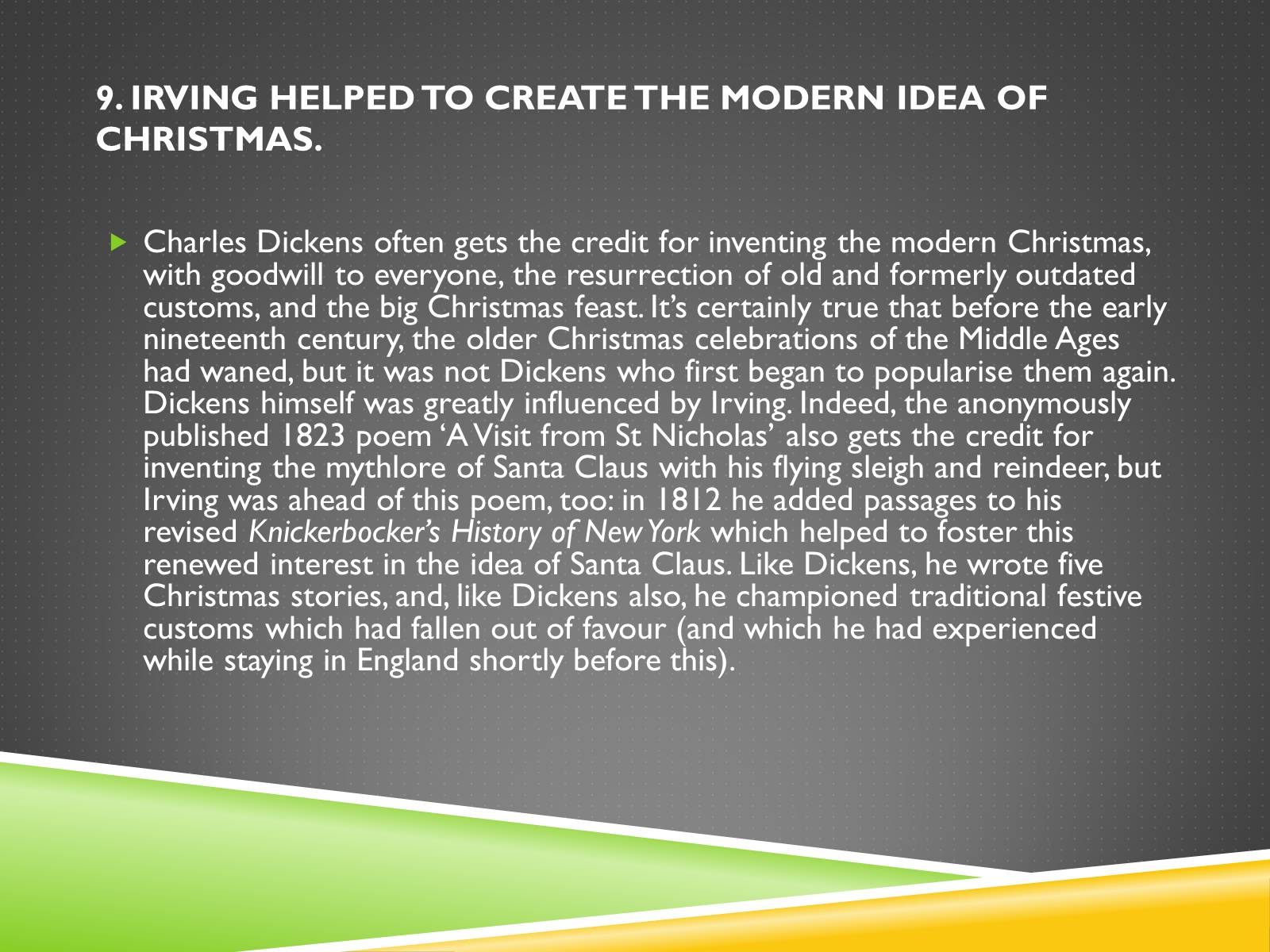- Головна
- Готові шкільні презентації
- Презентація на тему «Nine Interesting Facts about Washington Irving»
Презентація на тему «Nine Interesting Facts about Washington Irving»
226
Слайд #1
Nine Interesting Facts about Washington Irving
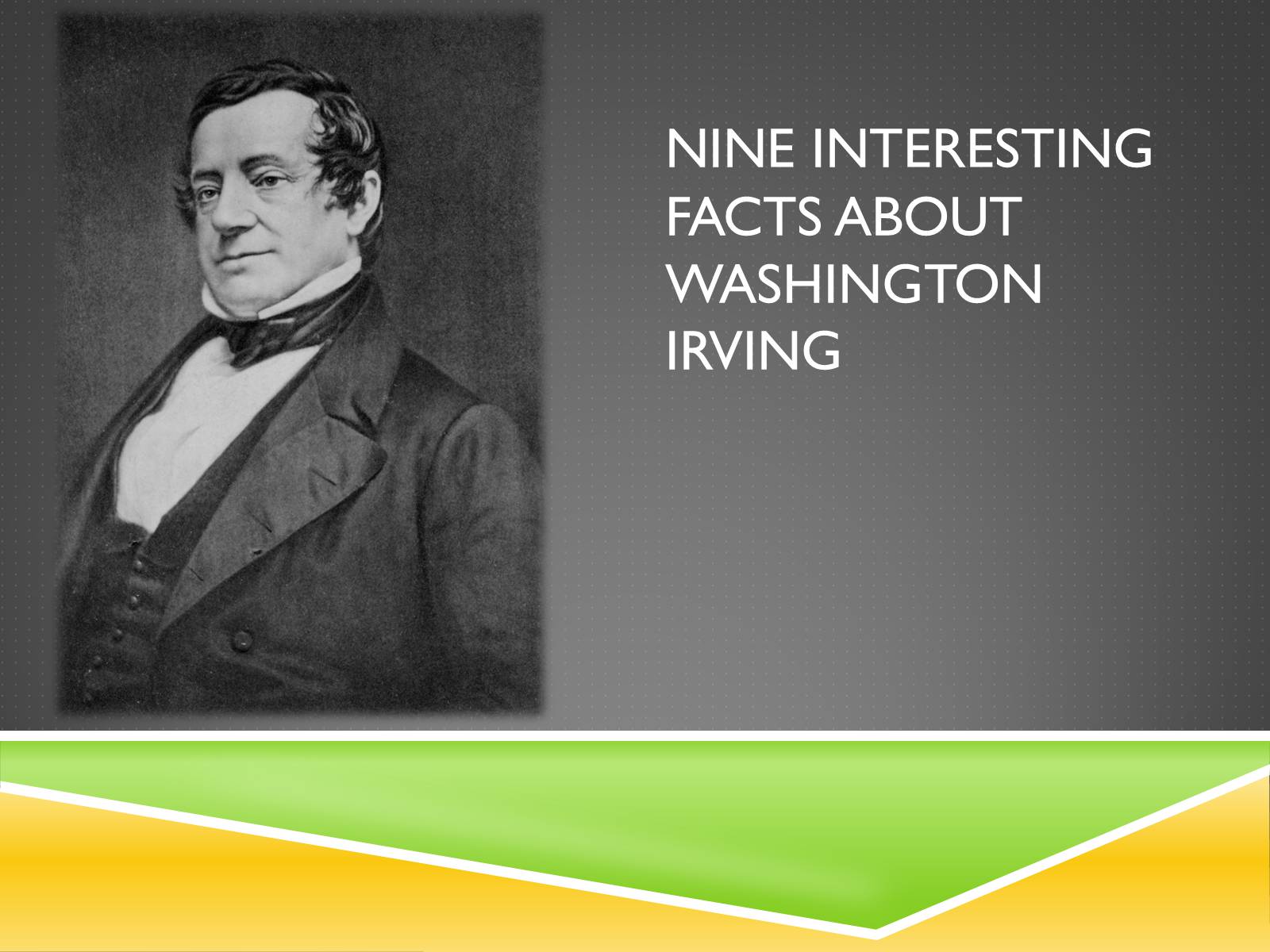
Слайд #2
1. Washington Irving was named after the first official President of the United States of America.
Born in 1783 in New York (the city that would loom large in his work), the American writer was named after the great American, George Washington. Of course, Washington only became President in 1789, but when Irving was born he was already known as an important founding father of the newly independent United States.
Born in 1783 in New York (the city that would loom large in his work), the American writer was named after the great American, George Washington. Of course, Washington only became President in 1789, but when Irving was born he was already known as an important founding father of the newly independent United States.
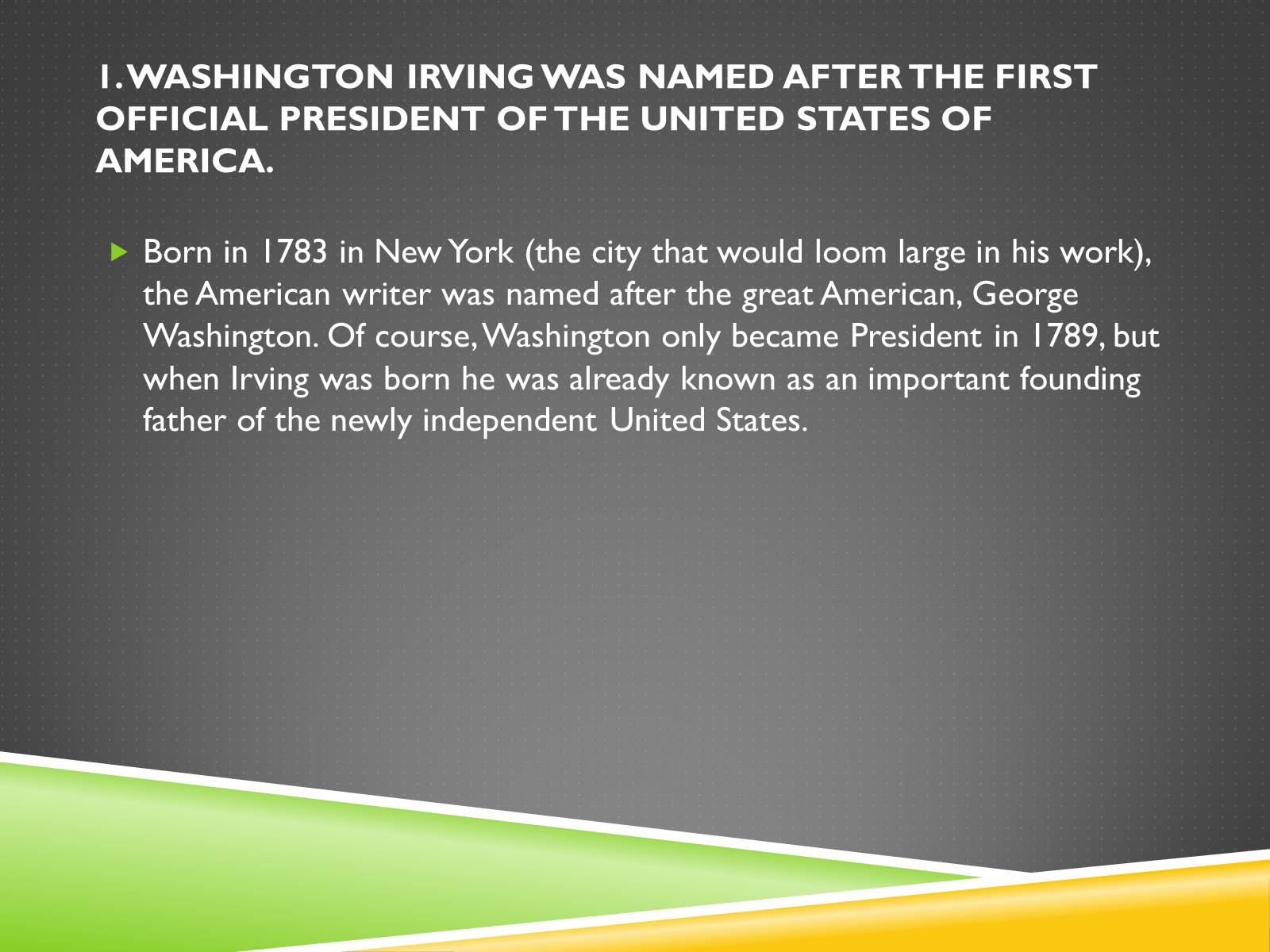
Слайд #3
2. His first book, Knickerbocker's History of New York (1809), gave us the Knickerbocker Glory.
Irving's first book was a humorous history of New York – yes, once again New York looms large in Irving's life – and was a huge success. But one of the great linguistic legacies of the work was that it gave us the name ‘Knickerbocker', which, following Irving's book, came to be used as a name for an inhabitant of New York (or a ‘native New Yorker', to quote from the song). The Knickerbocker Glory – a multi-coloured ice-cream sundae served in a tall glass – first appears in print in 1936 in a Graham Greene novel. The reasons for Irving's Knickerbocker being associated with this colourful dessert probably have something to do with our third, related, interesting fact …
Irving's first book was a humorous history of New York – yes, once again New York looms large in Irving's life – and was a huge success. But one of the great linguistic legacies of the work was that it gave us the name ‘Knickerbocker', which, following Irving's book, came to be used as a name for an inhabitant of New York (or a ‘native New Yorker', to quote from the song). The Knickerbocker Glory – a multi-coloured ice-cream sundae served in a tall glass – first appears in print in 1936 in a Graham Greene novel. The reasons for Irving's Knickerbocker being associated with this colourful dessert probably have something to do with our third, related, interesting fact …
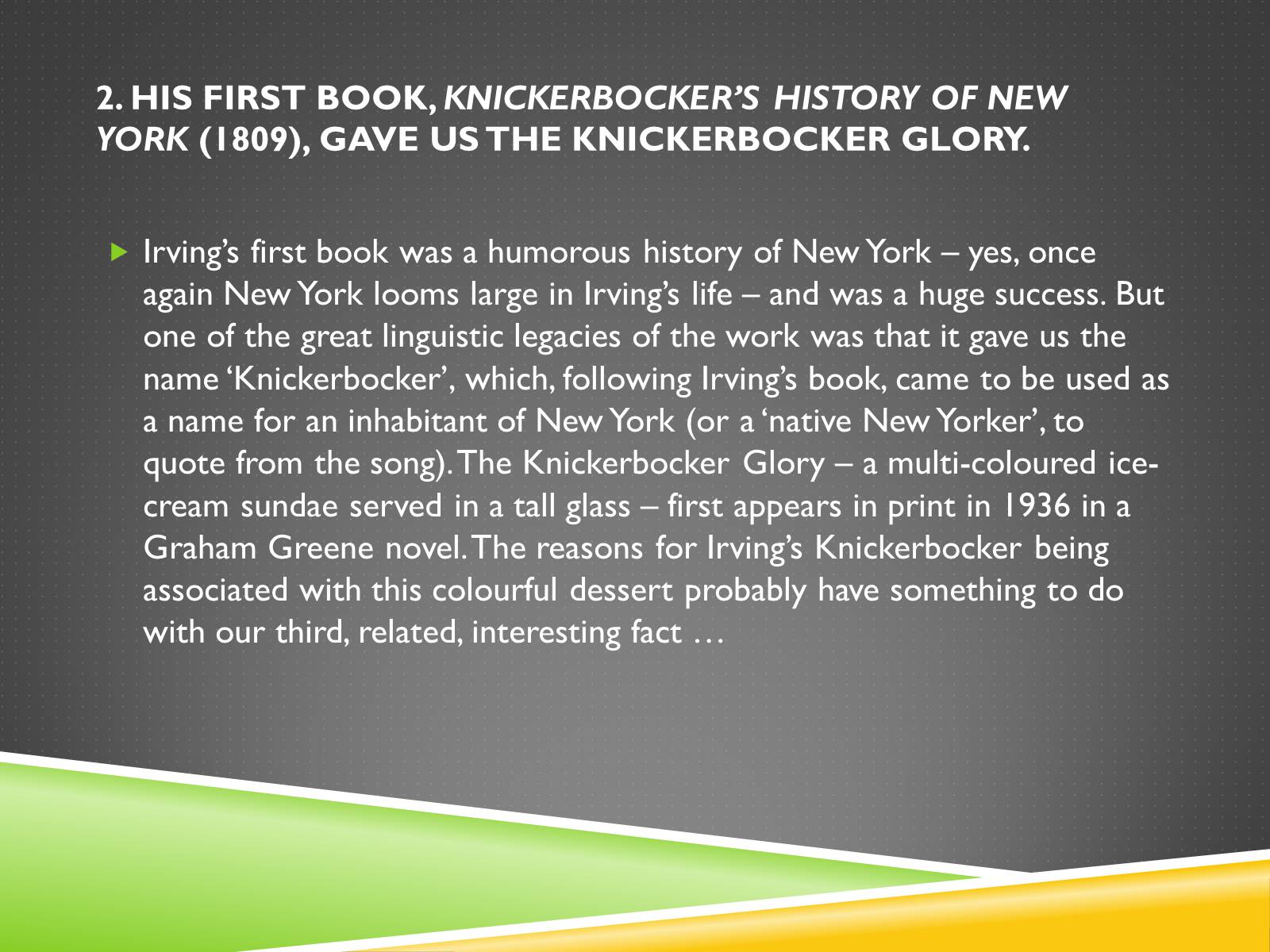
Слайд #4
3. Knickerbocker's History of New York (1809), gave us the word ‘knickers'. ‘Knickers' has never been out of use since.
Diedrich Knickerbocker was the fictional ‘author' of Irving's humorous ‘history', and Knickerbocker came to be used for any New Yorker. However, within half a century the word was being used to describe ‘loose-fitting breeches, gathered in at the knee, and worn by boys, sportsmen, and others who require a freer use of their limbs. The term has been loosely extended to the whole costume worn with these' (Oxford English Dictionary). Why the shift in meaning? One theory, which the OED offers, is that such garments resembled the knee-breeches worn by Knickerbocker in British artist George Cruikshank's illustrations to Irving's History of New York. At any rate, ‘knickers' had appeared by the 1880s, with the word shifting genders from men to women, and it has remained so ever since.
Diedrich Knickerbocker was the fictional ‘author' of Irving's humorous ‘history', and Knickerbocker came to be used for any New Yorker. However, within half a century the word was being used to describe ‘loose-fitting breeches, gathered in at the knee, and worn by boys, sportsmen, and others who require a freer use of their limbs. The term has been loosely extended to the whole costume worn with these' (Oxford English Dictionary). Why the shift in meaning? One theory, which the OED offers, is that such garments resembled the knee-breeches worn by Knickerbocker in British artist George Cruikshank's illustrations to Irving's History of New York. At any rate, ‘knickers' had appeared by the 1880s, with the word shifting genders from men to women, and it has remained so ever since.
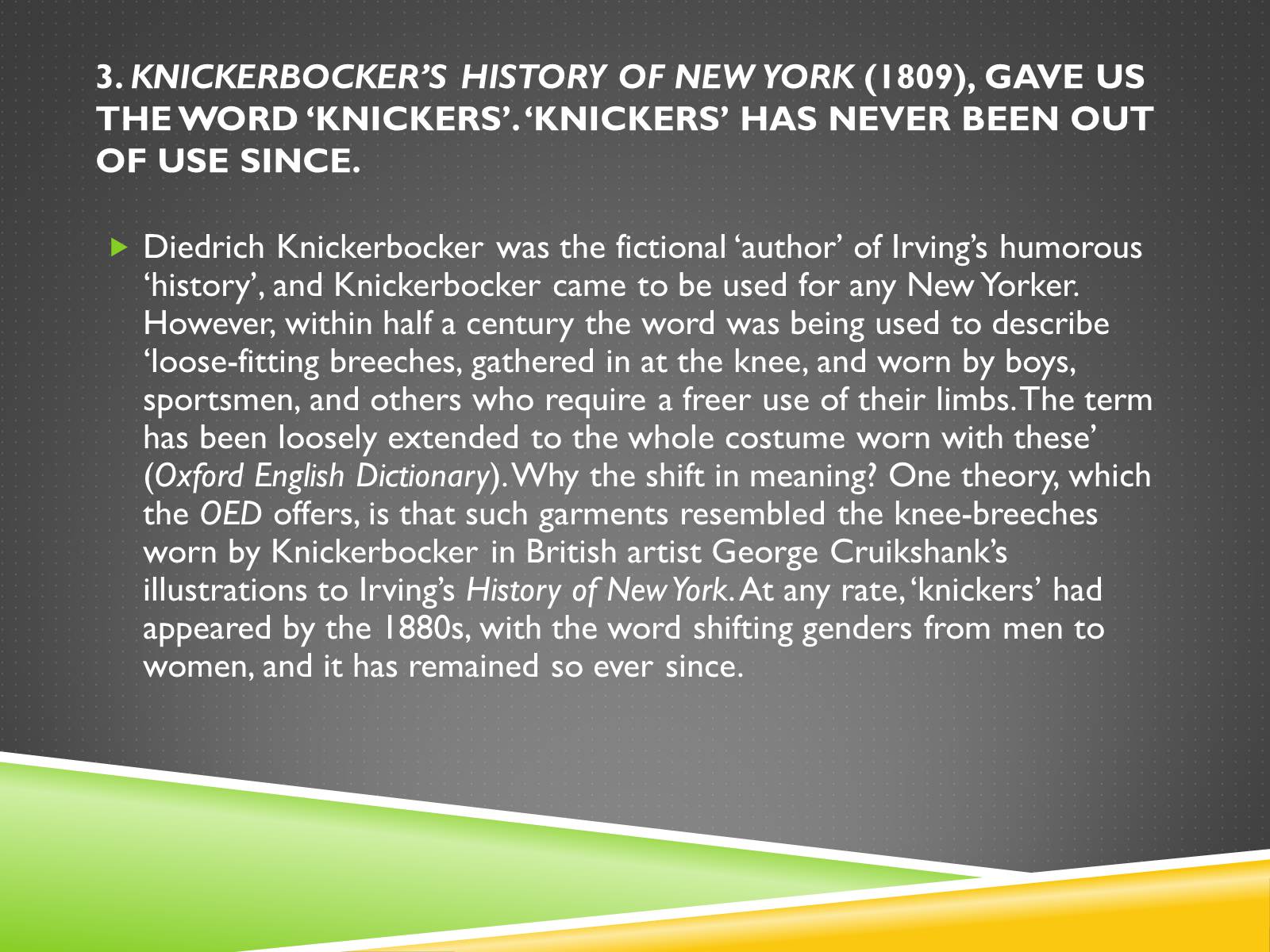
Слайд #5
4. Irving was the first person to refer to New York as ‘Gotham City'.
Yes, New York again. Irving first gave his hometown that sobriquet in 1807 in his satirical periodical Salmagundi. Irving borrowed the name from the Nottinghamshire village in England, which was reputedly inhabited by fools. Interestingly, the Nottinghamshire village is pronounced ‘Goat-em', whereas the nickname for New York is always ‘Goth-em'. Of course, since Irving first Christened New York ‘Gotham', the Batman comic strip and films have cemented the phrase ‘Gotham City' firmly in the American – and, indeed, the world's – psyche.
Yes, New York again. Irving first gave his hometown that sobriquet in 1807 in his satirical periodical Salmagundi. Irving borrowed the name from the Nottinghamshire village in England, which was reputedly inhabited by fools. Interestingly, the Nottinghamshire village is pronounced ‘Goat-em', whereas the nickname for New York is always ‘Goth-em'. Of course, since Irving first Christened New York ‘Gotham', the Batman comic strip and films have cemented the phrase ‘Gotham City' firmly in the American – and, indeed, the world's – psyche.
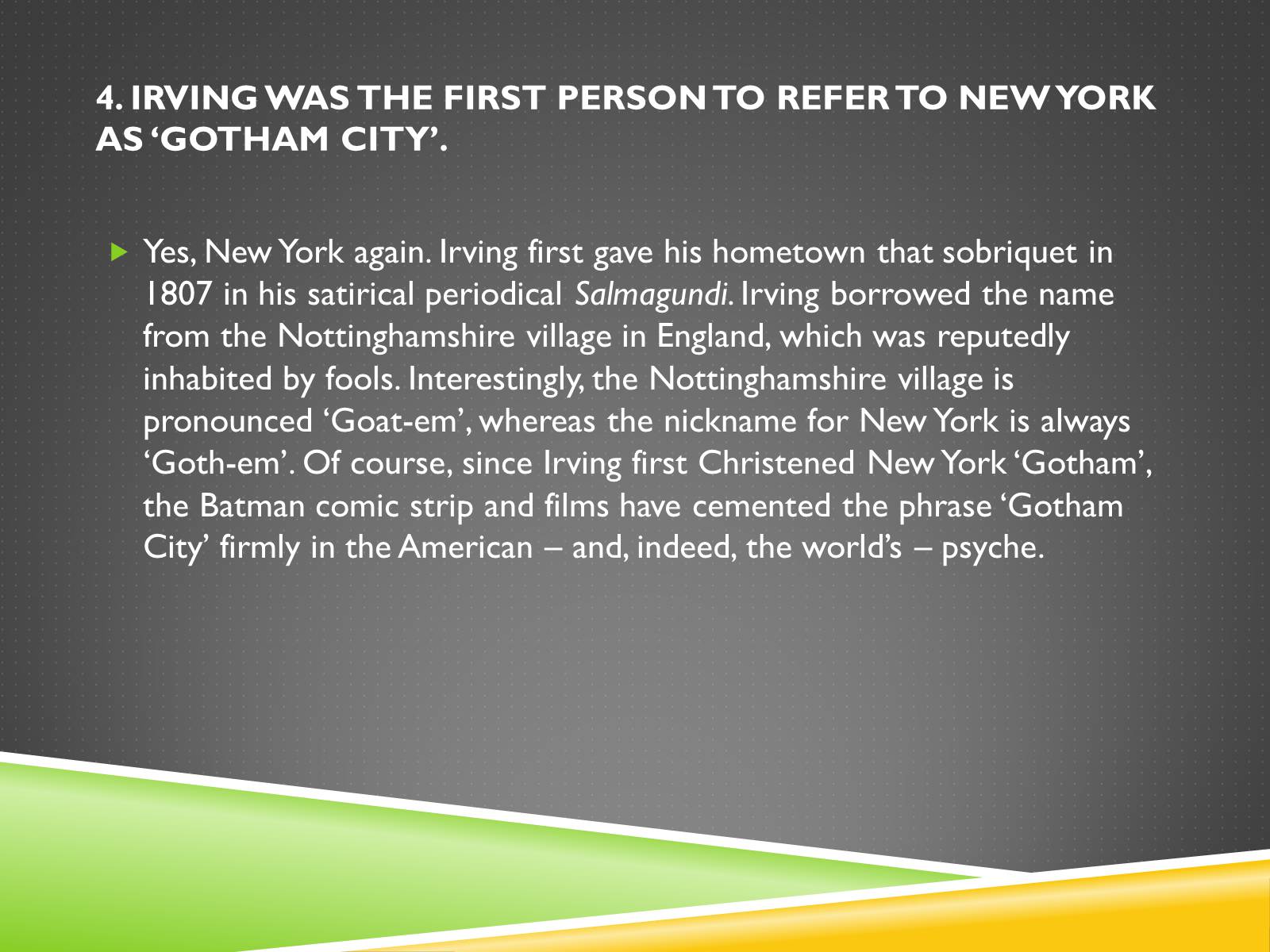
Слайд #6
5. Irving wrote the fairy story of Rip Van Winkle.
The story of the man who goes to sleep in the Catskill mountains and wakes up years later to find his wife dead and his son grown up was written by Irving while he was staying in England, in 1819. Rip Van Winkle goes to sleep for twenty years, not a hundred: some think he sleeps for a century because the tale is confused with Sleeping Beauty.
The story of the man who goes to sleep in the Catskill mountains and wakes up years later to find his wife dead and his son grown up was written by Irving while he was staying in England, in 1819. Rip Van Winkle goes to sleep for twenty years, not a hundred: some think he sleeps for a century because the tale is confused with Sleeping Beauty.
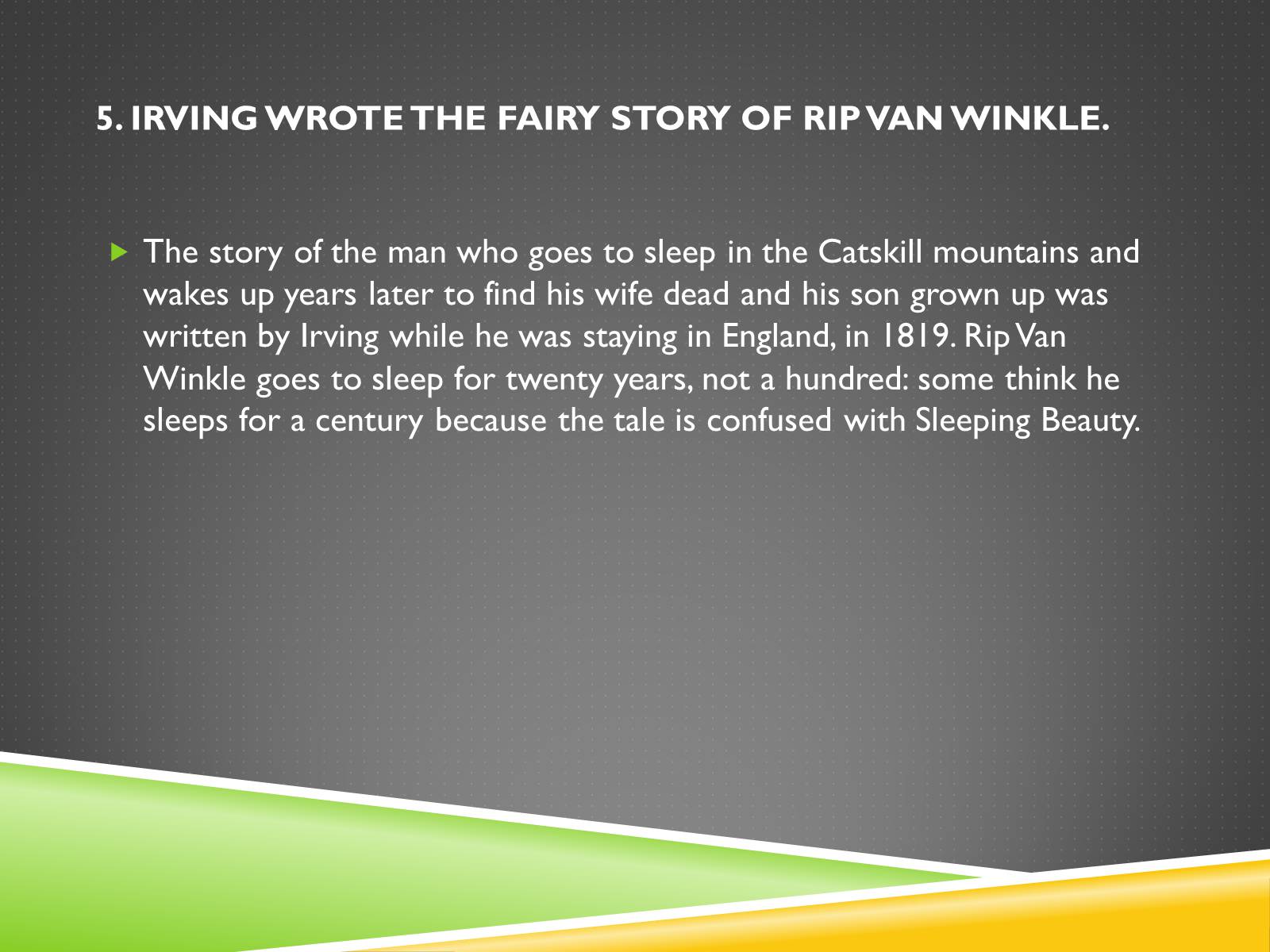
Слайд #7
6. He also wrote ‘The Legend of Sleepy Hollow'.
This was written a year after ‘Rip', in 1820, and was, of course, made into the Tim Burton film Sleepy Hollow in 1999. Irving is best-known for these two fairy tales.
This was written a year after ‘Rip', in 1820, and was, of course, made into the Tim Burton film Sleepy Hollow in 1999. Irving is best-known for these two fairy tales.
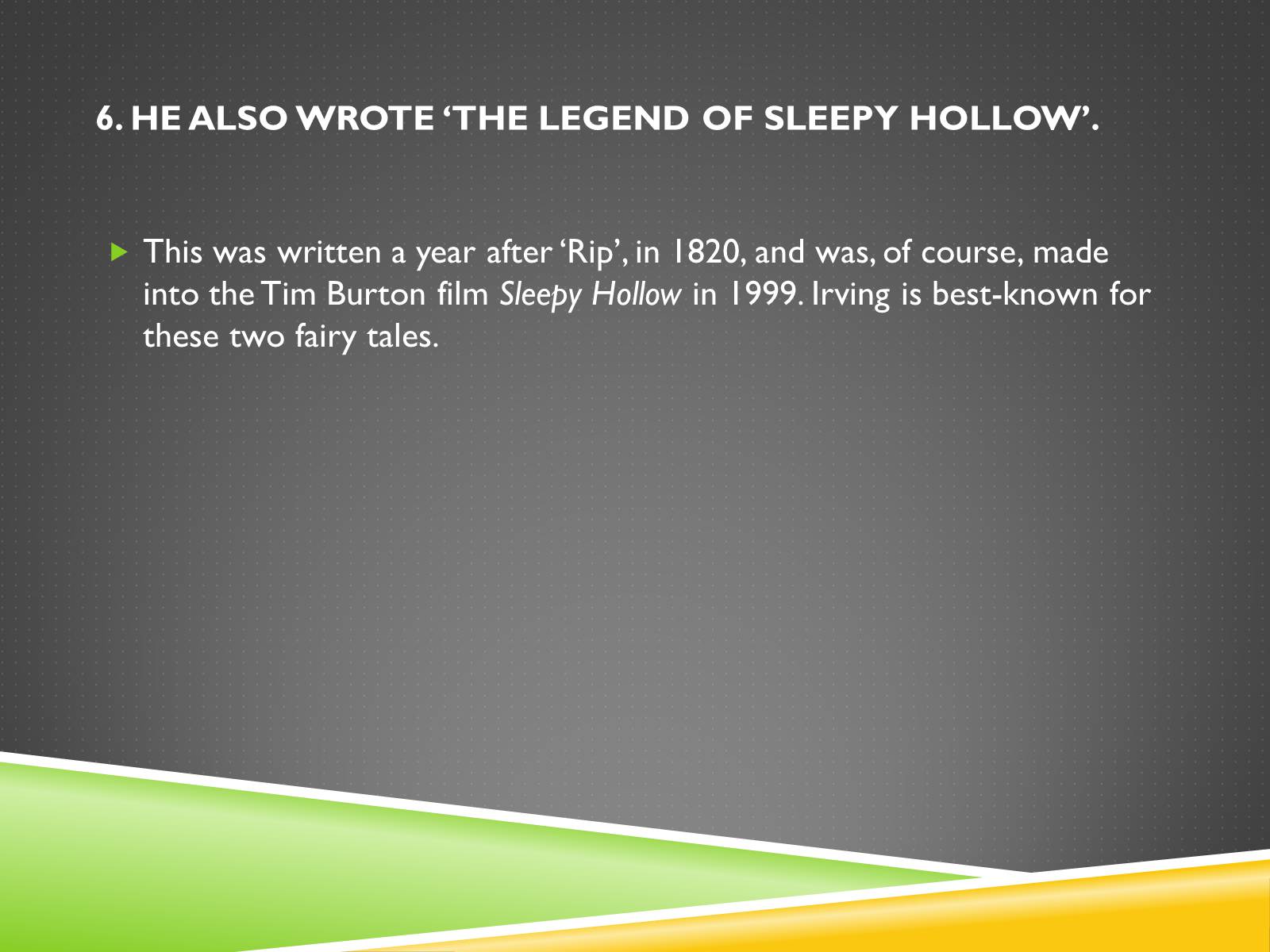
Слайд #8
7. He gave us the phrase ‘the almighty dollar'.
Not much to add on this one, except to say that he coined this phrase in 1837 in his story ‘The Creole Village'.
Not much to add on this one, except to say that he coined this phrase in 1837 in his story ‘The Creole Village'.

Слайд #9
8. Irving was responsible for the ‘flat earth' myth.
Once more, we're in the realm of foolish medieval folk. According to Jeffrey Russell in his 1991 book Inventing the Flat Earth, it was Irving's 1828 book A History of the Life and Voyages of Christopher Columbus which cemented the myth that medieval people thought the world was flat, whereas Columbus believed it was round. Indeed, the main bone of contention in the 1490s – at the time of Columbus's ‘discovery' of the New World – was more the size, rather than the shape of the world. But sometimes a myth can be more powerful than fact, and many still believe that Columbus's contemporaries all thought the world was flat and it might be possible to sail over the edge of it. Why did Irving invent the story then? Possibly to make Columbus look even more of a man ahead of his time than he was, as the great man who helped to found the New World, Irving's own homeland.
Once more, we're in the realm of foolish medieval folk. According to Jeffrey Russell in his 1991 book Inventing the Flat Earth, it was Irving's 1828 book A History of the Life and Voyages of Christopher Columbus which cemented the myth that medieval people thought the world was flat, whereas Columbus believed it was round. Indeed, the main bone of contention in the 1490s – at the time of Columbus's ‘discovery' of the New World – was more the size, rather than the shape of the world. But sometimes a myth can be more powerful than fact, and many still believe that Columbus's contemporaries all thought the world was flat and it might be possible to sail over the edge of it. Why did Irving invent the story then? Possibly to make Columbus look even more of a man ahead of his time than he was, as the great man who helped to found the New World, Irving's own homeland.

Слайд #10
9. Irving helped to create the modern idea of Christmas.
Charles Dickens often gets the credit for inventing the modern Christmas, with goodwill to everyone, the resurrection of old and formerly outdated customs, and the big Christmas feast. It's certainly true that before the early nineteenth century, the older Christmas celebrations of the Middle Ages had waned, but it was not Dickens who first began to popularise them again. Dickens himself was greatly influenced by Irving. Indeed, the anonymously published 1823 poem ‘A Visit from St Nicholas' also gets the credit for inventing the mythlore of Santa Claus with his flying sleigh and reindeer, but Irving was ahead of this poem, too: in 1812 he added passages to his revised Knickerbocker's History of New York which helped to foster this renewed interest in the idea of Santa Claus. Like Dickens, he wrote five Christmas stories, and, like Dickens also, he championed traditional festive customs which had fallen out of favour (and which he had experienced while staying in England shortly before this).
Charles Dickens often gets the credit for inventing the modern Christmas, with goodwill to everyone, the resurrection of old and formerly outdated customs, and the big Christmas feast. It's certainly true that before the early nineteenth century, the older Christmas celebrations of the Middle Ages had waned, but it was not Dickens who first began to popularise them again. Dickens himself was greatly influenced by Irving. Indeed, the anonymously published 1823 poem ‘A Visit from St Nicholas' also gets the credit for inventing the mythlore of Santa Claus with his flying sleigh and reindeer, but Irving was ahead of this poem, too: in 1812 he added passages to his revised Knickerbocker's History of New York which helped to foster this renewed interest in the idea of Santa Claus. Like Dickens, he wrote five Christmas stories, and, like Dickens also, he championed traditional festive customs which had fallen out of favour (and which he had experienced while staying in England shortly before this).
